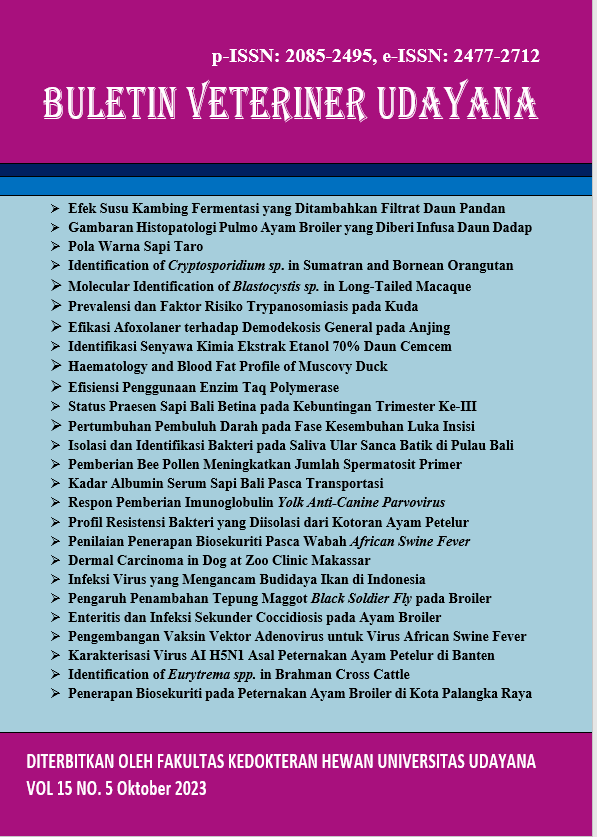ENTERITIS AND SECONDARY INFECTION COCCIDIOSIS IN BROILER CHICKEN AT TEGAL, CENTRAL JAVA
Abstract
Excessive chlorination in chicken drinking water can trigger pathogenic microbial infection, such as Eimeria protozoa infection which causes coccidiosis. This disease can cause losses in farmers because it causes poor weight gain and high mortality. In this study, it was known that broiler chicken on farm in Tegal were reported with inappetence, lethargy, weakness, paleness and bloody diarrhea. Water examination was performed and found 600 ppm chlorine in the drinking water and the litter thickness was less than 5 cm. Post mortem examination found enlargement of the heart and kidney, caecal tonsil and caecal bleeding, swelling of the intestine and enteritis. Based on that pathological anatomy lesion and examination of oocysts per gram of feces, the chicken diagnosis as enteritis followed by coccidiosis as a secondary infection due to Eimeria tenella with a severe infection. Therefore, control can be carried out by giving Capzuril® or Agricox®, vitamin K, vitamin A and probiotics and prevention by controlling the chlorination of the drinking water and increasing the thickness of the litter.
Downloads
References
Arellano-Gutiérrez G, Aldana-Zaragoza EH, Pérez-Fabián A. 2021. Intestinal perforation associated with chlorine dioxide ingestion: an adult chronic consumer during COVID-19 pandemic. Clin. J. Gastroenterol. 1: 1655-1660.
Arsyitahlia N, Ardana IBK, Apsari IAP. 2019. Prevalensi infeksi Eimeria spp. pada ayam pedaging yang diberik pakan tanpa antibiotik growth promoters (AGP) di Kabupaten Tabanan, Bali. Indon. Med. Vet. 8(2): 186-192.
Aviagen. 2019. Best practice on the farm: water chlorination during production. https://www.thepoultrysite.com/articles/best-practice-on-the-farm-water-chlorination-during-production. [25 Mei 2023]
Aziz T. 2005. Chlorinating drinking water on poultry farms. World Poult. 21: 24-25.
Badan Pusat Statistika (BPS). 2022. Populasi Ayam Ras Pedaging Menurut Provinsi (Ekor), 2020-2022. https://www.bps.go.id/indicator/24/478/1/populasi-ayam-ras-pedaging-menurut-provinsi.html. [25 Mei 2023]
Debbou-Iouknane N, Benbarek H, Ayad A. 2018. Prevalence and aetiology of coccidiosis in broiler chickens in Bejaia province, Algeria. Onderstepoort J. Vet. Res. 85(1): 1-6.
Direktorat Kesehatan Hewan. 2014. Coccidioss. Manual Kesehatan Unggas. https://wiki.isikhnas.com/images/6/6c/COCCIDIOSIS.pdf. [30Maret 2023]
Direktorat Kesehatan Hewan. 2014. Indeks Obat Hewan Indonesia (IOHI). Direktorat Jenderal Peternakan, Departemen Pertanian RI.
Ekawasti F, Martindah E. 2019. Pengendalian Koksidiosis Pada Ayam Melalui Pengobatan Herbal. Wartazoa. 29(1): 001-012.
Hamid PH, Kristianingrum YP, Wardhana AH, Prastowo S, Silva LMRD. 2018. Chicken coccidiosis in Central Java, Indonesia: A recent update. Vet. Med. Int. 2018: 8515812.
McDougald. 2009. Protozoal Infections. In: Saif YM (ed) Diseases of poultry. 12th Ed. Blackwell Publishing. UK. Pp. 1067-1080.
Mesa-Pineda C, Navarro-Ruíz JL, López-Osorio S, Chaparro-Gutiérrez JJ, Gómez-Osorio LM. 2021. Chicken coccidiosis: from the parasite lifecycle to control of the disease. Front. Vet. Sci. 8: 787653.
Plumb DC. 2008. Toltrazuril. In: Plumb's veterinary drug handbook. 6th Ed. Blackwell Publishing. Stockholm. Pp. 896.
Sasada T, Hinoi T, Saito Y, Adachi T, Takakura Y, Kawaguchi Y, …, Ohdan H. 2015. Chlorinated water modulates the development of colorectal tumors with chromosomal instability and gut microbiota in Apc-deficient mice. PLoS One. 10(7): e0132435.
Shirley MW, Lillehoj HS. 2012. The long view: a selective review of 40 years of coccidiosis research. Avian Pathol. 41(2): 111-121.
Taylor MA, Coop RL, Wall RL. 2016. Intestinal coccidiosis, Parasites of poultry and gamebirds. In: Veterinary parasitology. 4th Ed. Wiley Blackwell. UK. Pp. 693-701.
Turney RL, McAllister JE. 2022. Assessment of Coccidia in Poultry in Guyana. J. Agruc. Life Sci. 9(1): 1-12.





